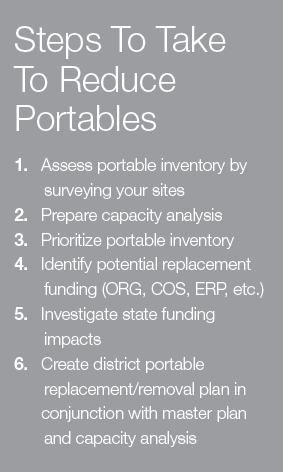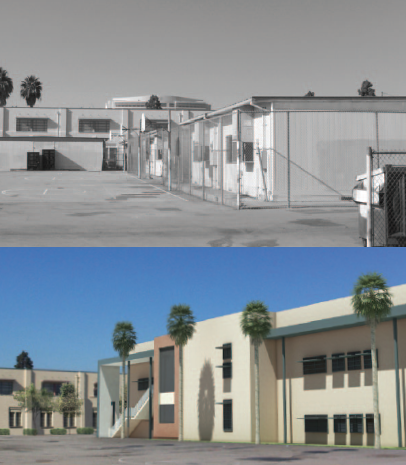By Joe Dixon, Assistant Superintendent, Santa Ana USD and Coalition for Adequate School Housing (C.A.S.H.) Board Member, and Steve Wilkerson, Principal, HMC Architects
 At campuses across the state, thousands of portables—also known as modular classrooms—have been dropped onto hard courts or field spaces as afterthoughts to the original school design. This add-on strategy to address rapid enrollment growth and the resulting emphasis to deliver schools as inexpensively as possible has compromised the integrity of school designs and their associated instructional programs.
At campuses across the state, thousands of portables—also known as modular classrooms—have been dropped onto hard courts or field spaces as afterthoughts to the original school design. This add-on strategy to address rapid enrollment growth and the resulting emphasis to deliver schools as inexpensively as possible has compromised the integrity of school designs and their associated instructional programs.
A Quick-fix History
Prior to 1998, the California State Lease Purchase Program (LPP) required that new school construction projects design in at least 30 percent of classroom spaces as portable. The concept was that portable classrooms could be moved from school to school to accommodate enrollment changes in a local district from one school boundary to another. The sudden advent of K-3 class size reduction and the rapid population growth of the 1990s accounted for portable classroom “tent cities” on campuses.
Unresolved Challenges
Now, the problems of compromised school designs and loss of dedicated instructional spaces have been further complicated by the deterioration of the portable buildings and the increasing costs of maintaining those buildings. At one point in the State construction program, the State Allocation Board (SAB) assisted districts in acquiring portable buildings through a leasing program; however, the SAB now has acknowledged the escalating costs of maintaining such buildings. The cost of maintaining a portable classroom can be as high as $17,214 for ten years, $26,791 for fifteen years, $52,229 for twenty years, and a whopping $67,481 for twenty-five years! The solution for the SAB–get out of the portable leasing business!
The Portable Solution
The solution for the Santa Ana Unified School District was the same: get out of the portable classroom business. If the District had any hope of reducing capital costs, returning spaces to their intended instructional purposes, and providing quality learning environments for students, it had to begin an effort to reduce the numbers of portable classrooms in its inventory.
 Portables: Before and after at Santa Ana USD
Portables: Before and after at Santa Ana USD
With the passage of Measure G, $200 million General Obligation bond, in June 2008, Santa Ana USD was able to qualify for $45 million in state matching funds from the Critically Overcrowded Schools program under Prop 47. The goal was to replace 156 portable classrooms. This goal was accomplished in less than sixteen months from design to occupancy. Measure G also allowed the district to access $57 million under Prop 1D, the Overcrowding Relief Grant, to replace portables with permanent structures at five schools resulting in the removal of 120 additional portables. In total, the district will reduce its 768 portables to less than 100 within three years, reducing the annual cost of maintenance from $2,142,157 to under $200,000.
Everyone agrees, now is the time to look for efficiencies in operations. Portables are definitely a great place to start.
This article originally appeared in the 2010/2011 edition of School News.
View the presentation from the 2010 C.A.S.H. Conference.
